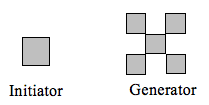Fractal Dimension
Learning Outcomes
- Define and identify self-similarity in geometric shapes, plants, and geological formations
- Generate a fractal shape given an initiator and a generator
- Scale a geometric object by a specific scaling factor using the scaling dimension relation
- Determine the fractal dimension of a fractal object
 Certain rules apply for scaling objects, related to their dimension.
If I had a line with length 1, and wanted to scale its length by 2, I would need two copies of the original line. If I had a line of length 1, and wanted to scale its length by 3, I would need three copies of the original.
Certain rules apply for scaling objects, related to their dimension.
If I had a line with length 1, and wanted to scale its length by 2, I would need two copies of the original line. If I had a line of length 1, and wanted to scale its length by 3, I would need three copies of the original.
 If I had a cubical box with sides of length 1, and wanted to scale its length and width by 2, I would need eight copies of the original cube. If I wanted to scale the length and width by 3, I would need 27 copies of the original cube.
If I had a cubical box with sides of length 1, and wanted to scale its length and width by 2, I would need eight copies of the original cube. If I wanted to scale the length and width by 3, I would need 27 copies of the original cube.
 Notice that in the 1-dimensional case, copies needed = scale.
In the 2-dimensional case, copies needed = scale[latex]^{2}[/latex].
In the 3-dimensional case, copies needed = scale[latex]^{3}[/latex].
From these examples, we might infer a pattern.
Notice that in the 1-dimensional case, copies needed = scale.
In the 2-dimensional case, copies needed = scale[latex]^{2}[/latex].
In the 3-dimensional case, copies needed = scale[latex]^{3}[/latex].
From these examples, we might infer a pattern.
Scaling-Dimension Relation
To scale a D-dimensional shape by a scaling factor S, the number of copies C of the original shape needed will be given by:[latex]\text{Copies}=\text{Scale}^{\text{Dimension}}[/latex], or [latex]C=S^{D}[/latex]
Example
Use the scaling-dimension relation to determine the dimension of the Sierpinski gasket. Suppose we define the original gasket to have side length 1. The larger gasket shown is twice as wide and twice as tall, so has been scaled by a factor of 2. Notice that to construct the larger gasket, 3 copies of the original gasket are needed.
Using the scaling-dimension relation [latex]C=S^{D}[/latex], we obtain the equation [latex]3=2^{D}[/latex].
Since [latex]2^{1}=2[/latex] and [latex]2^{2}=4[/latex], we can immediately see that D is somewhere between 1 and 2; the gasket is more than a 1-dimensional shape, but we’ve taken away so much area its now less than 2-dimensional.
Solving the equation [latex]3=2^{D}[/latex] requires logarithms. If you studied logarithms earlier, you may recall how to solve this equation (if not, just skip to the box below and use that formula with the log key on a calculator):
Take the logarithm of both sides.
Notice that to construct the larger gasket, 3 copies of the original gasket are needed.
Using the scaling-dimension relation [latex]C=S^{D}[/latex], we obtain the equation [latex]3=2^{D}[/latex].
Since [latex]2^{1}=2[/latex] and [latex]2^{2}=4[/latex], we can immediately see that D is somewhere between 1 and 2; the gasket is more than a 1-dimensional shape, but we’ve taken away so much area its now less than 2-dimensional.
Solving the equation [latex]3=2^{D}[/latex] requires logarithms. If you studied logarithms earlier, you may recall how to solve this equation (if not, just skip to the box below and use that formula with the log key on a calculator):
Take the logarithm of both sides.
[latex]3={{2}^{D}}[/latex]
Use the exponent property of logs.[latex]\log(3)=\log\left({{2}^{D}}\right)[/latex]
Divide by log(2).[latex]\log(3)=D\log\left(2\right)[/latex]
The dimension of the gasket is about 1.585.[latex]D=\frac{\log\left(3\right)}{\log(2)}\approx1.585[/latex]
Scaling-Dimension Relation, to find Dimension
To find the dimension D of a fractal, determine the scaling factor S and the number of copies C of the original shape needed, then use the formula[latex]D=\frac{\log\left(C\right)}{\log(S)}[/latex]
Try It
Determine the fractal dimension of the fractal produced using the initiator and generator.
Answer:
 Scaling the fractal by a factor of 3 requires 5 copies of the original.
Scaling the fractal by a factor of 3 requires 5 copies of the original.
[latex]D=\frac{\text{log}\left(5\right)}{\text{log}\left(3\right)}\approx1.465[/latex]
Licenses & Attributions
CC licensed content, Original
- Question ID 131177. Authored by: Lumen Learning. License: CC BY: Attribution.
- Revision and Adaptation. Provided by: Lumen Learning License: CC BY: Attribution.
CC licensed content, Shared previously
- Fractal dimension . Authored by: OCLPhase2. License: CC BY: Attribution.
